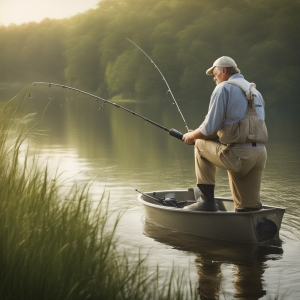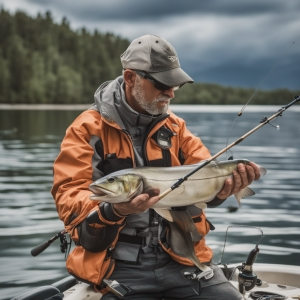Table of Contents:
## Einleitung
When it comes to outdoor activities, fishing is a favorite for many. It's peaceful, enjoyable and allows you to connect with nature while potentially catching dinner. However, like any other outdoor activity, it comes with its own set of safety precautions. Whether you're a seasoned angler or just getting started, these essential tips will ensure you have a safe and enjoyable fishing experience.
Prepping for your Fishing Expedition: Understanding the Basics
Before you get out there and cast your line, you need to understand the basics of fishing safety. Firstly, always ensure you have the correct gear. Fishing gear is not just about rods, reels, and bait. It includes necessary safety items like life jackets, first aid kits, and even sun protection. Secondly, never go fishing alone. Fishing is fun, but it is also unpredictable, and having a buddy with you can be a potential lifesaver.
Safety on the Water: Protecting Yourself and Others
Fishing often involves being near or on water bodies. Always remember, water safety is paramount. Wearing a life jacket not only abides by law, but it could also save your life especially if you fall overboard. If you’re fishing in a river, be aware of the current and never wade in water above your knees. Always take note of local weather conditions and be ready to take shelter if a storm brews.
Pros and Cons of Fishing Safety Methods
| Method | Pros | Cons |
|---|---|---|
| Wearing Life Jackets | Improves survival chances dramatically in the case of falling into the water. | Can be uncomfortable or restrictive when casting and reeling. |
| Using a Buddy System | Ensures there is someone to provide help or call for assistance if needed. | Can limit the amount of space and peace during fishing. |
| Keeping Equipment in Good Condition | Prevents unexpected gear failures which could lead to potentially dangerous situations. | Requires regular maintenance and checks, which could be time-consuming. |
| Bringing Communication Devices | Allows for immediate contact with emergency services in case of a crisis. | May require a power source or may have limited coverage in remote areas. |
Post-Fishing Safety Measures: Ensuring a Safe Return

Once you're done fishing, your safety precautions shouldn't end. Make sure all your fishing gear is safely packed away, to avoid injuries while transporting it. Be sure to thoroughly clean up your area, leaving no fishing line, bait or waste behind. Leaving debris behind is not just bad for the environment, it can also pose a threat to wildlife. Lastly, always check yourself for ticks, especially if you have been fishing near wooded areas.
Conclusion
Fishing is a fantastic way to enjoy the great outdoors, but safety should always come first. By following these essential fishing safety tips, you can ensure that your fishing experience is not only enjoyable but also safe. Remember, being prepared and aware of your surroundings is key to a secure and successful day on the waters.
Introduction: The Importance of Safety While Fishing

Fishing, a beloved pastime by many, enables you to not only engage with nature but also provides an opportunity for relaxation and potential food source. Regardless of its recreational aspects, fishing requires proper safety precautions to ensure the well-being of every participant. The significance of safety while fishing parallels that of any other adventure sport or outdoor activity. Irrespective of your experience level, being a neophyte or a veteran angler, adhering to critical safety rules is an absolute must - an informed angler is a safe angler.
Understanding the Basics of Fishing Safety
At the backbone of a safe fishing trip are the basics of fishing safety, and it all begins with proper planning. Know your excursion region well, learning about the potential hazards, local weather conditions and wildlife in the area. It's essential to let someone know where you're going and how long you'll be gone. Providing detailed information about your plans can be incredibly helpful in case of an emergency where others might need to locate you.
Active wear fitting to the weather and environment is crucial. You may need to invest in good quality rain gear, insulated garments, or sun-protective clothes depending on the situation. Gloves can protect your hands from hooks and fish teeth and hats can also protect you from the sun's harmful rays.
Last but definitely not least, familiarize yourself with basic first aid. Accidents can happen and knowing how to respond to minor injuries could turn out to be vital.
Choosing the Right Safety Gear for Fishing

Acquiring the right gear isn't simply confined to what might help you reel in the biggest catch. It also includes gear that significantly contributes to your safety during your expedition. The mainstay of safety gear is the life jacket or personal flotation device (PFD). Don't ignore it even if you're an adept swimmer. Unexpected circumstances like abrupt weather changes or slippery surfaces could lead to accidents.
Another safety tool that should be in your fishing arsenal is a first aid kit, filled with essentials like bandages, antiseptic wipes, tweezers, medical tape, and a digital thermometer. Also, don't forget the bug spray and sunblock.
Other crucial safety gear includes a safety whistle, sturdy waterproof boots, and a flashlight or headlamp, especially if you're planning to fish until twilight or before dawn. Remember, the best angler isn't just the one who catches the most or the biggest fish, but one who comes back home safe and sound.
Safe Casting Techniques: Mastering the Art of Casting Safely
While it's crucial to cast your line effectively to catch fish, it’s equally important to cast safely. Always lookout for your surroundings before you cast. Make sure there are no people, trees, or powerlines near your casting area that might get caught in your line. When casting, use smooth, even motions to prevent hooks from flying unpredictably.
Be cautious with fish hooks – they are sharp and can cause significant injuries. Always handle them carefully and make sure to put them away safely when not in use. If you're fishing with children, consider using safety caps on hooks to prevent any injuries.
Remember, your fishing skills are not solely judged by how many fishes you can catch, but also by how safely you can cast and handle your fishing equipment.
Understanding Weather Conditions and Safety
Weather has a significant role to play when it comes to fishing safety. You should always check the weather forecast before heading out to fish. Favourable conditions are not only better for actually catching fish but also uphold safety. Swift changes in weather can cause dangerous conditions, especially if you're out on a boat.
If you are fishing from a boat, be sure to be equipped with a reliable weather radio so you can keep abreast of weather changes. Look out for the formation of dark clouds, sudden drop in temperature, or increasing wind, as these could be indicative of a storm brewing.
Moreover, adjust your plans according to the weather. Don't insist on fishing during an ongoing storm - it is extremely dangerous due to the risk of lightning strikes. It's much safer to pause, seek shelter, and wait for the storm to pass before continuing with your fishing expedition.
On sunny days, use sunblock, wear a hat and sunglasses to protect from harmful UV rays. Also, remember to stay hydrated and take a break if it gets too hot. Fishing can wait, but your health and safety cannot. Be smart and respect the power of nature.
Safety Measures While Fishing near Water Bodies
Fishing near water bodies adds another layer of necessary precautions to ensure your safety. Before stepping into a water body, it's vital to keep an eye out for slippery surfaces that could cause accidental falls. Likewise, assess the current's speed before wading in. When fishing from a boat, make sure to secure the boat properly before you start, avoid standing and lean over to prevent being tipped out.
Keeping track of the water's depth is also crucial. A sudden deep spot can catch you off guard and potentially lead to dangerous situations. Have a float plan if you are on a boat, especially when fishing in open water bodies.
Familiarity with various distress signals is beneficial. In case of an emergency, you can use these signals to alert others around you. Also, having a whistle or other noise-making device could prove critical when you need to attract attention.
Last but not least, remember to stay hydrated and protected from the sun. Temperatures can rise drastically on the water, making sunscreen and adequate water, essential items in your fishing gear.
How to Handle Your Catch Safely
When it comes to handling your catch, safety should be at the forefront of your mind. Fish hooks can be sharp and dangerous, and improper hook removal can result in injury both to you and the fish.
The safest way to handle fish is to keep them in the water as much as possible. Removing a fish from its aquatic environment can cause unnecessary stress and potential harm. If you plan to release the fish back into the water, the less you handle it, the better for its survival.
Use a fish landing net to safely remove the fish from the water. Choose one made from rubber or knotless nylon, which is less destructive to fish and their scales. If you must handle the fish, do so with wet hands or moist gloves to minimize the removal of their protective slime.
When removing the hook, use a pair of needle-nose pliers or a hook-out tool. Always be mindful of the hook’s position, keeping your fingers away from it to prevent any accidental injuries. If the hook is deeply embedded or the fish swallows it, it's safer to cut the line as close to the hook as you can.
Lastly, if you've caught a large or potent fish species, be extremely careful when handling it. Some fish have sharp teeth, gills, or other defensive mechanisms that can cause harm if not properly handled.
First Aid Tips for Fishing Enthusiasts
Being prepared with essential first aid knowledge can make a huge difference in the outcome of fishing mishaps. Therefore, it's important to have a well-stocked first aid kit that includes items such as bandages, antiseptic cream, tweezers for removing hooks, and pain relief medication. Moreover, learning how to perform CPR and knowing how to treat common injuries like cuts, sprains, and burns can be invaluable in emergency situations.
Stay vigilant at all times and avoid hazards. Watch out for slippery surfaces and be extra careful when dealing with hooks - a careless moment can lead to a puncture wound. In case of a hook injury, disinfect the area and use tweezers to remove the hook. If the hook is embedded too deeply, seek professional medical help.
It's also important to be aware of the symptoms of heat exhaustion and dehydration especially when fishing in hot weather. Drink plenty of water, take breaks in shade and protect your skin from the sun. If you or a fellow angler shows signs of heatstroke, such as dizziness, rapid heartbeat, or confusion, cool down and seek immediate medical attention.
Bugs and insects can be more than a nuisance - some bites and stings can be dangerous. Carry an insect repellent and wear protective clothing. If you're stung, remove the stinger if possible, clean the area, and apply a cold compress to minimize swelling. If severe symptoms occur, such as difficulty in breathing, seek emergency help immediately.
Fishing can take you into remote locations. In case of getting lost, a good strategy is to stay where you are to increase the chances of being found. Carry a signaling device such as a whistle to attract attention.
Conclusion: Ensuring Safe and Fun Fishing Adventures
In conclusion, safety is the cornerstone of any fishing adventure. Taking the necessary precautions, understanding the risks, and being prepared can make your trip both enjoyable and secure. It's important to remember, fishing is not just about the catch, but about the experience and the respect shared with the great outdoors. Utilize the safety gear available to you, be aware of your surroundings, respect wildlife and other anglers, and, above all else, enjoy your time on the water. By prioritizing safety, fishing can indeed remain a treasured and safe activity for all.
Frequently Asked Questions: Ensuring Safety and Fun in Fishing
What should I wear for a safe fishing trip?
Wearing appropriate clothing and gear is necessary. It's recommended to wear a hat, sunglasses for eye protection, boots with good traction, and to apply plenty of sunblock. In cooler climates, waterproof jackets and thermal wear are also crucial.
What type of equipment do I need to ensure safety while fishing?
The necessary equipment depends on the type of fishing. However, some essentials include a life jacket, first aid kit, proper baits and hooks, a fishing rod, a line cutter, and needle nose pliers. It's also advised to carry a signaling device in case of emergencies.
What precautions should be taken when fishing in a boat?
Safety precautions include wearing a life jacket at all times, knowing the boat's capacity, checking the vessel for any potential issues before setting out, understanding weather conditions and water currents, carrying communication devices, and not consuming alcohol during the trip.
How can I safely handle the fish I catch?
Fish can be safely handled by using wet hands or gloves to prevent damage to their skin, avoiding contact with gills, and removing hooks with care. If a fish swallow the hook, it's better to cut the line rather than to attempt removing it by force.
What is catch and release and how can it be done safely?
Catch and release is a practice wherein the fish are released after catching, to preserve the fish population or for sporting purposes. For a safe release, minimize the handling and exposure of the fish, remove the hook carefully, and release the fish gently into the water as soon as possible.







